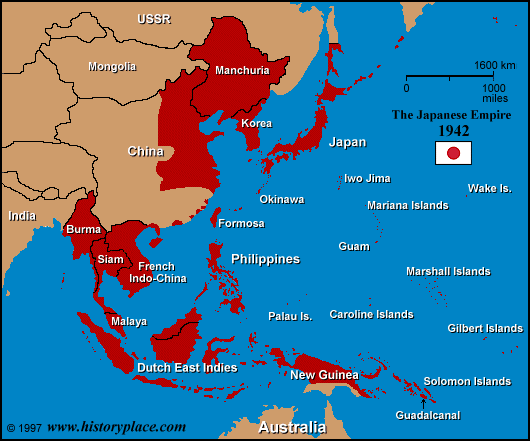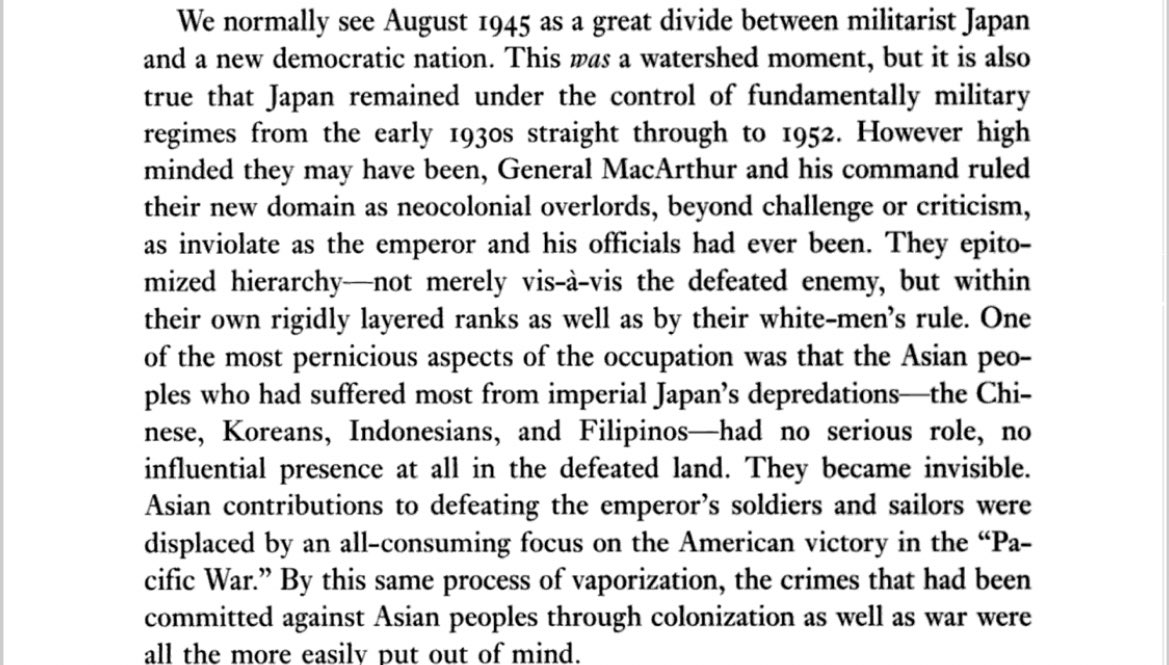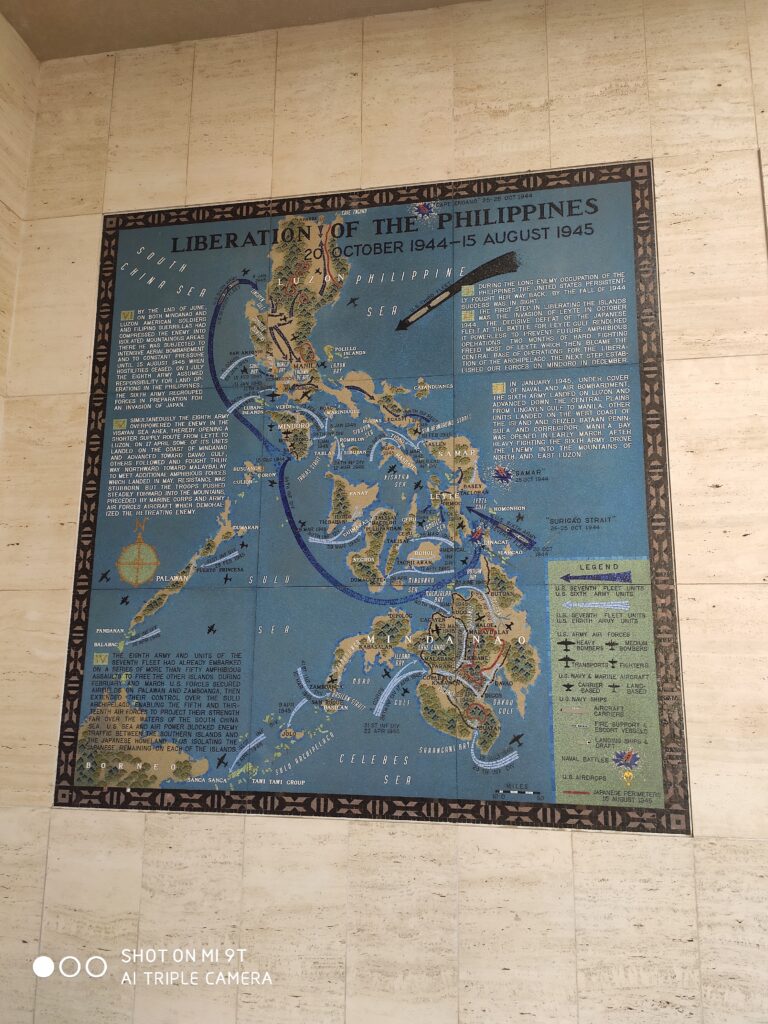The causes of this war are in the “Move to Global War’ section.
Practices of War
When studying the Pacific theatre of the Second World War it is easy to think of why the US forces won. After all, there are countless images, movies and documentaries showing this. It is also common to think the war began in 1941. However, as the students who study Move to Global War and the Chinese Civil War, you will know that this is more a western perspective. Furthermore, in 1941 the US military was relatively weak compared to the Japanese. They were underfunded (a consequence of the Depression years) and inexperienced (compared to the Japanese who had been fighting in China). When Germany invaded Poland in September 1939, US defence spending significantly increased but it would take time to equip and train the army, navy and air force sufficient to defeat the Japanese Imperial Forces. Therefore, when developing arguments for this conflict you should bear in mind the reasons why it took the US-led Allies so long to defeat Japan.
Pearl Harbor
The Japanese attack on Pearl Harbor, Hawaii, was a pyrrhic victory. It succeeded in damaging all eight battleships and destroyed 188 aircraft. However, the three aircraft carriers were out at sea for the attack so escaped any damage; equally the docks and power stations were intact – these would allow the US Navy to rebuild quickly. Operation Hawaii was, therefore, a success but also a long-term failure.
- The Japanese attack on Pearl Harbor demonstrated the effectiveness of aircraft carriers. It is an accepted view that a key error of the Japanese was that they did not destroy the US carriers, which were out at sea when the attack took place. This would have a consequence in future battles. However, the Japanese attacks could not have taken place without them, it was an amazing feat of strategy and secrecy to launch a surprise attack over 4000 miles with thirty-three ships.
- The attack also saw the value of dive bombers. The following explanation is useful to understand these relatively new weapons.
- The Japanese dive bombers also had torpedoes that could be launched in shallow waters, overcoming the ‘impregnability’ of Pearl Harbor.
- The US underestimated the Japanese military power, believing that the decision to move the US Fleet to Pearl Harbor would deter any future Japanese aggression towards the Philipinnes or other US bases. Read this article to find out the US strategic errors regarding Japan.
- But the Japanese also made a strategic error, one that the planner of the attack on Pearl Harbor, Admiral Yamamoto, was anxious about. If their navy had attacked the Dutch East Indies, there may not have been a response from the USA. After all, ‘America First‘ was the isolationist slogan in the country and many did not want lives lost for another European war, especially not to preserve their empires.
- ‘From the Japanese perspective, the attack on Pearl Harbor was a great success. Eight battleships were sunk and 18 other ships were damaged. The Japanese virtually wiped out the American air capability with the loss of 180 planes and with 128 damaged. The United States also suffered 2,403 killed in action and 1,178 wounded in action. Japanese losses were relatively minor — 29 planes and 55 officers and men.’ Richmond Newspaper
- The US perspective would see the battle as both a lucky escape and also a huge failure. The former because many more ships could have been destroyed. The latter because US intelligence and the government had read reports of Japanese plans for war. But they thought Pearl Harbor was a very strong fortress for its navy and that if a conflict broke out, the Japanese would attack the Europeans first.
Battle Of Midway
This battle was a turning point in the war in Asia. It was fought between the Imperial Japanese and US navies in June 1942. Although instigated by the Japanese, the battle resulted in a US victory, enabling them to become the stronger naval power in the Pacific. It was possible that Japan would lose the Pacific war but it was more likely after the Battle of Midway. However, it is important to understand that Japan continued to increase the size of its empire after Midway, reaching a peak in 1943. The Allies still had a great deal to do to defeat Japan in the second half of the Pacific War.
As a result of the Doolittle Raid (the bombing of Tokyo), Admiral Yamamoto prepared an attack on the US naval fleet. His plan was to invade the island of Midway (an important base for both US air and naval forces) which would then lull the US fleet at Pearl Harbor (1000 miles away) into trying to counter or repulse them. On arriving, they would be attacked by a large and unexpected Japanese fleet, overwhelming numbers and force would destroy the US ships. However, this plan failed because the US intelligence broke part of their code and they were prepared for the attack.
The Japanese forces were at a disadvantage during the Pacific War, they were fighting on two fronts, against the Chinese since 1937 and the western imperial powers since 1941.
The use of technology was considerable at the Battle of Midway. It was used by both US and Japanese naval and air forces.
- The US forces broke the Japanese secret code (sources vary of how much could be deciphered – anywhere from 25 to 80% success). The cryptography unit which achieved this was called hypo.
- As a result, the commander of the US Pacific fleet Admiral Nimitz could direct his forces where the Japanese least expected them. For example, when they bombed the island of Midway, aiming for the airfields and the bombers who were stationed there, the aircraft had taken off hours earlier (unlike Pearl Harbor). The US bombing force was flying to bomb the Japanese Navy instead.
- Effective aerial reconnaissance by the US aircraft allowed their forces to be directed at crucial points during the battle. The Japanese had their own ‘scouts’ but they were not as successful in finding their enemies.
- Radar was a key weapon of the American naval force. It allowed ship commanders to locate enemy ships and aircraft over long distances. Although the Japanese battle tactics were just as effective as the US in 1942, they relied on human lookouts rather than radar.
- The aircraft carriers were the key weapon in the Asian theatre of the Second World War. They changed the nature of naval warfare, able to defeat any surface ship with its aircraft, from as much as 200 miles away. The Doolittle Raid proved that even bombers could take off from these ships so nowhere was safe, these mobile airfields could be taken anywhere. This article explains how the aircraft carrier changed the way navies fought. And this article was written just after the Battle of Midway had ended, explaining how valuable this relatively new weapon is to future naval strategy.
- The largest carriers in World War II were around 800 feet long, 90 feet wide, and carried around 100 planes.
- The US and Japanese both had some of the best naval and air weaponry of the Second World War. At Midway, the Japanese had the advantage in air power with their Zero fighter. The US did not yet have the famous Mustang available but eventually were able to develop a variety of aircraft which were comparable to the Mitsubishi Zero.
- The aircraft carriers’ effectiveness at the Battle of the Coral Sea (fought in May 1942) proved that battleships, cruisers and destroyers were less influential in naval battles.
- The Japanese thought they were facing only two aircraft carriers at Midway, the Yorktown was supposed to have been destroyed at Coral Sea. However, she made it back to Pearl Harbor, was quickly restored and was put to sea to support the US forces at Midway.
- Based on the intelligence Nimitz received, he sent his three carriers to ambush the Japanese main strike group.
- US reconnaissance aircraft found this force and Midway-based aircraft were sent to engage. However, they were unsuccessful and the surviving bombers flew back to Midway. Admiral Nagumo, commander of the Japanese forces at Midway, wanted to destroy these aircraft. They would be on the ground so he changed the weaponry of his fighters from anti-ship to land. These changes would take up to two hours. Unfortunately for him, a US force of carriers arrived in this time period and their aircraft were able to attack Nagumo’s force with little resistance as a result. He had also waited for the Midway attack force to land and refuel before attacking himself. These decisions cost the Japanese fleet the Battle of Midway.
Perspectives
‘After the battle of Midway… the advantage the Japanese had lost could never be made good… Six fleet carriers would join the Japanese navy between 1942 and 1944, America launched fourteen, as well as nine-light carrier and sixty-six escort carriers, creating a fleet against which Japan could not stand. It was now condemned to the offensive‘. John Keegan
Island Hopping
The US-led strategy after Midway was to bomb and expel the Japanese forces from the many islands of the Pacific. They then could build and operate airfields and supply bases to dislodge further enemy forces.
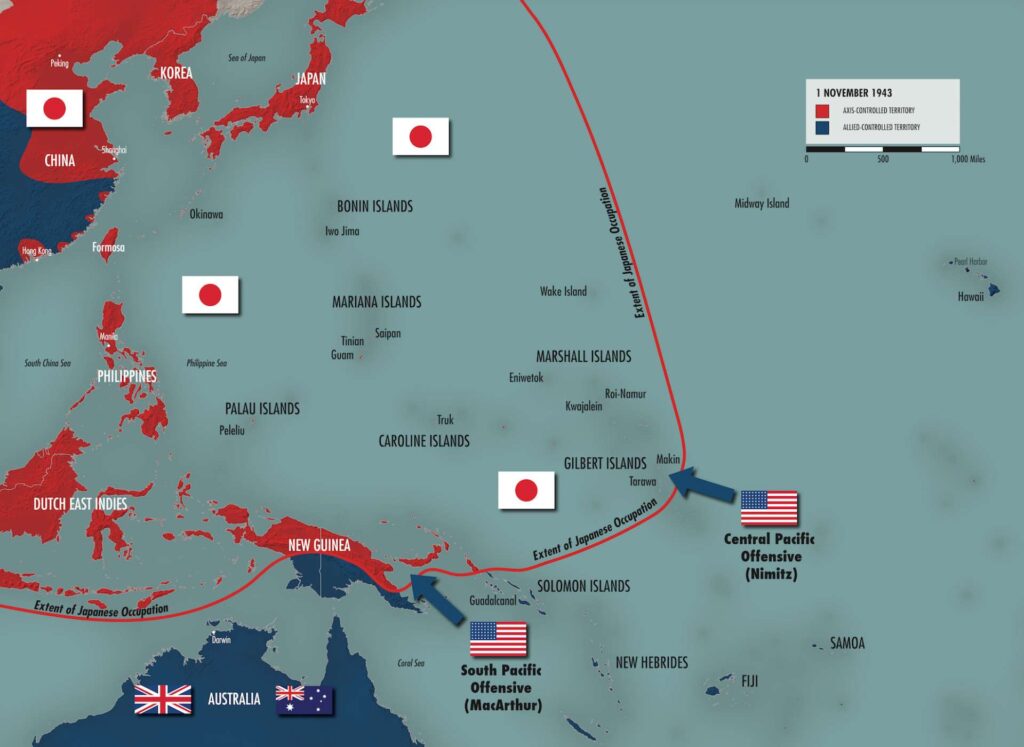
The US forces also wanted to disrupt Japanese supply lines to pressurise them into changes their strategies and possibly force an end to the war.
- The US’ strategy was to use their economic and human resources to be the decisive factor in the Pacific – these will be used to cut off Japan’s supply lines in Asia. The US had ten times the industrial capacity of Japan and importantly could be self-sufficient in natural resources.
- Japan did not make full use of its population, deciding not to force all civilians into the workforce. For example, in the US the number of working women increased by fifty per cent. In contrast, the female labour force rose by only ten per cent.
- The Japanese government and society were still patriarchal and this had an influence on how many women became part of the war effort. Many believed that the family unit was important to the stability and harmony of the society so expected women to raise the children and look after the home.


- The US strategy was two-fold. The Army wanted to take Papua New Guinea, the Solomon Islands and eventually the Philipinnes. This would cut off the Japanese from their territories in the Dutch East Indies (now Indonesia). However, the Navy wanted to seize islands to the north and create a series of bases where they could cut off the Japanese supply lines. Both strategies were accepted.
- One of the reasons the Japanese lost the war in the Pacific is because their navy and army had different agendas and goals, they did not coordinate their forces. Their land forces were fighting or occupying in south-east Asia or China. Their navy was expanding or holding onto their empire in the Pacific, sometimes thousands of miles apart. The US navy and army did not operate as independently as the Japanese, they fought in similar areas with the same purpose – cutting off Japanese supply routes.
- In August 1942, the Allies attacked the island of Guadacanal. This battle began with amphibious landing and it took six months before the Japanese evacuated. Both sides tried to land more troops and this led to naval battles taking place to make time and space in order to do so. Nearly fifty ships were destroyed in these battles.
- The landings were evidence of the US’ new strategy to launch landing crafts or Higgins Boats from ships and covering them with artillery or air support. This support was important to the success of the amphibious landings on many of the islands, proving the value of the US’ human and economic resources.
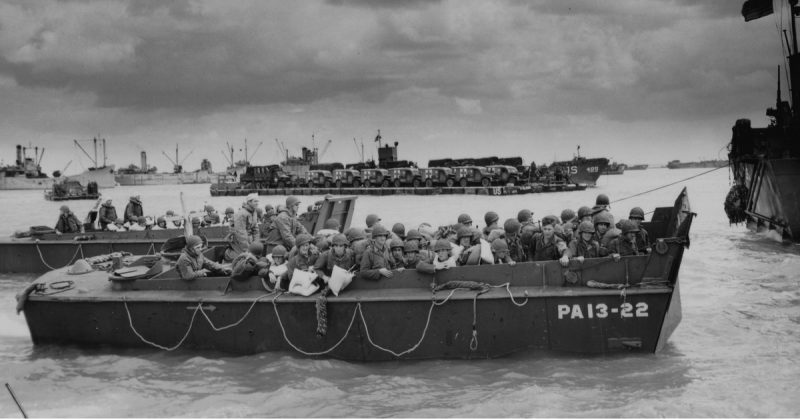
- The Battle for Guadacanal also included aerial combat, making a conflict where all three arms fought: air, sea and land.
- Japan lost 24 000 killed and the US more than 7 000, it was costly for both sides. The Japanese soldiers rarely surrendered owing to their code of honour (bushido) and the propaganda which their government had issued. Therefore, the fighting for the US forces was extremely difficult and the Japanese always had much higher casualties.
- As a result, the US forces planned much longer bombardments of enemy-held islands before launching their amphibious assaults.
- Papua New Guinea followed in the summer of 1943 but it was another hard-fought victory for the US forces.
- The navy fared better because they had four of the new ‘Essex-class‘ aircraft carriers, bigger and faster than any other at the time.
- Their collection of new aircraft, fighters, dive-bombers and torpedo bombers, could outperform and outnumber their Japanese enemies.
- The Battle of the Philippines Sea was the US attempt at retaking the Philippines. This was the biggest aircraft battle of all time – resulting in a decisive victory for the US. Several important Japanese carriers were destroyed and they could not make up the losses.
- By 1944, Japan began to run out of oil. She turned to kamikaze or divine wind as one of her solutions. The weather had come to Japan’s aid in the past (preventing invasions) so it would do again. The difference was that the wind was in the form of aircraft, a one-way flight for pilots to destroy the US Fleet.
- The Japanese Army launched its own banzai attacks, soldiers advancing suicidally to try and destroy their enemies.
- Japan launched offensives against the US but they were no longer surprised. If the US radar did not spot them, the sheer number of aircraft or submarines certainly would. The resources of the US became more influential as the war continued.
1940 September – Japan take French Indo-China
1941 December – Pearl Harbor, Hong Kong fell to the Japanese
1942 January – Malaya taken
1942 February – Singapore taken, a major British defeat.
1942 April – Philipinnes taken, a major US defeat. Doolittle Raid
1942 May – Battle of Coral Sea, perhaps a draw.
1942 June – Midway, a Japanese defeat
1942 November – Battle for Guadacanal begins
1943 February – Japan loses Guadacanal
1943 April – Admiral Yamamoto dies.
1944 June – Battle for the Philipinnes begins.
1944 November – First B-29 bomber raids on Tokyo.
1945 March – Japan lose the Philipinnes.
1945 April – Okinawa taken, Roosevelt dies and is replaced by Truman.
1945 May – Victory in Europe against the Axis
1945 August – USSR attacks Japan in Manchuria, two atomic bombs dropped on Hiroshima and Nakasaki. A few days later Japan surrenders.
The Atomic Bomb
The dropping of Little Boy and Fat Man changed the world. These two atomic bombs were dropped on Hiroshima and Nagasaki respectively. Watch the following documentary to learn more.
Technology, Resources and Foreign Powers
- The US began developing its atomic bomb via the Manhattan Project. This was in response to the intelligence that Germany was building their own. It is clear that the US had Germany as the main target for the weapon once it had been produced. Killing civilians had become part of the Second World War, the Blitz, Bomber Offensive and the Tokyo Fire Raids all occurring before August 1945. See this page to learn more about the Second World War in Europe.
- Arguably, the Tokyo fire raids killed more than the atomic weapons on Hiroshima and Nagasaki (83 000 in Tokyo and 60 to 80 000 for Hiroshima). Read this article to find out more. But the technology of this single weapon demonstrated to the world that warfare had changed and the balance of power was steered towards whoever possessed such a bomb.
- One of the arguments why the US dropped the bomb is because they feared the influence of the USSR over a future Japan. At the Potsdam Conference in July 1945, they had already agreed to enter the war in Asia, easily defeating the Japanese Imperial Forces in Manchuria when they did so in August. It was possible that they could take the mainland next.
- The argument used by the US government was the number of casualties their forces were going to face. It was predicted that the war in the Pacific would take another year to finish. The following points were made in reaching the decision to drop the bomb:
- Aerial bombing by aircraft was not capable of inflicting defeat on the enemy, ground forces were required to do this.
- The Japanese proved in the island-hopping campaign that they would not surrender. Their honour and the constant propaganda explaining how the US forces behaved in a barbaric manner (they raped, tortured and killed all captives) to all prisoners maintained this resistance. There was some evidence of this but both sides committed atrocities. The propaganda in the US and Japan aimed at dehumanising the enemy so they would be easier to kill.
- The Japanese had proved extremely effective soldiers, the US did not underestimate them (perhaps they did at the beginning of the war).
- The Big Six and the emperor were in charge of making the key military decisions for Japan. It was dominated by the military with only one person, Togo, not having served. US intelligence knew that they were divided in how to end the war and could not agree that they should accept the US proposals to surrender. Some wanted to continue fighting to get a better settlement.
- The defence of Okinawa in April 1945, Japan’s fifth-largest island, resulted in nearly 50 000 casualties (over 110 000 Japanese). This was further evidence that, even though Japan was being slowly defeated, they would continue to fight to the end. If the US-led ground forces invaded the mainland, resistance would be considerable.
- The Battle of Okinawa also showed the power of the kamikaze pilots, resulting in thirty ships being sunk and damaging a further 223. The navy also attacked suicidally, the battleship Yamato attempting to destroy the US navy (it failed because US carrier aircraft sunk it before it could do any damage).
- The US experiences in retaking the Philipinnes from the Japanese in 1944/45 led them to consider a more short-term solution to the ending the war in the Pacific. The battle cost the US over 16 000 dead, although the Japanese cost was far higher at over 300 000 and Filipino during the occupation over a million.
- Estimates at US casualties range from 50 000 to over one million. The former figure is heavily disputed although President Truman did quote them once. However, he also quoted other figures so one cannot only use the lowest figure as his prediction. The former president, Hoover, estimated 500 000 to one million, the US Chief of Staff George Marshall 500 000, and Churchill – over one million.
- These figures varied because the estimates for the size of the Japanese defences did too. Initially, the US expected 350 000 defenders and up to 3500 aircraft. However, by late-July these had risen to 2.6 million troops and over 10 000 aircraft.
- John A. Lynn argues that the US was right to drop the atomic weapons on Japan, citing many of the reasons above. He argues that the bombing actually saved Japanese lives (although acknowledges that the US government did not give this as a reason to act). It killed thousands in the short-term but more civilians would have been killed long-term.
- On the other hand, historians such as Ronald Takaki argue that the US dropped the atomic bomb on Japan because of their racist superiority. He also quotes Truman’s lowest estimated figures to support his theories.
- The aircraft Enola Gay dropped the first bomb on Hiroshima on 8 August 1945. Between 80 to 100 000 people were killed. The US considered it a military target as there were 42 000 soldiers and an army headquarters. However, they knew masses of civilians would be killed too.
- The USSR attacked in Manchuria on 8 August 1945, easily pushing the Japanese backwards.
- The Japanese government knew the human cost of Hiroshima but the cabinet was still split on surrendering.
- The attack on Nagasaki killed 45 000 straight away.
- There was a third bomb available to Truman to use within a few weeks but it was not needed. The US strategy was to give the impression that they had several to increase the chances of the Japanese surrender (this proved effective as the army minister thought the US had more than one-hundred).
- Consequently, Japan decided to accept the Potsdam Declaration although maintained its position that the emperor’s role could continue…this was accepted.
Peacemaking
The Treaty of San Francisco was signed in 1951 and ended the US occupation of Japan.
- Japan did try to negotiate the end of the war in the Pacific but the US disagreed with their proposals. For example, in June 1945 the Big Six wanted to keep the emperor as head of state, maintain a limited military, be free from any occupation and any war crimes tribunals, and give back the European colonies only when they had released them from their clutches. The US only accepted the first.
- In July 1945, the Allied leaders met at Potsdam to discuss, among many things, the final stages of the war in the Pacific. They offered Japan their terms for surrender but they were rejected by a divided cabinet.
Territorial Changes
- The US occupied Japan until 1951.
- The colonies Japan gained in the war were taken off them.
Political Impacts
https://www.amazon.com/Embracing-Defeat-Japan-Wake-World/dp/0393320278
Governments gained more power during the war.
World War II – After the War. This is useful for unit 15 too, how the war had an impact on the UK and Germany.
- Japan was forced to accept a democratic state with the military not having power.
- The accusations of racism of the US towards Japan continued after the war. Their policy of internment remained controversial after the war. History.com
Social Impact
Women
Japan
Japan did not make full use of its population, deciding not to force all civilians into the workforce. For example, in the US the number of working women increased by fifty per cent. In contrast, the female labour force rose by only ten per cent.
The Japanese government and society were still patriarchal and this had an influence on how many women became part of the war effort. After the war, it was argued that upper-class values prevented working-class women from being conscripted. It was expected that they comfort bereaved families, raise children and be prudent with the needs of the household. Although Germany made more use of her women (an increase of 37.4 per cent in 1939 to 52.5 in 1944), the allies were more effective in bringing them into the workforce.
Few women were in professional occupations, they remained male.
The Greater Japan Women’s Association was set up in 1942 to organise women to work in the economy. However, it did not have much success because of the failure of the government to pass conscription.
The main job for women in Japan was agriculture. Very few had professional jobs and this did not change in the war despite the labour shortage. And war factories preferred male rather than female labour.
But the Japanese did enlist the efforts of unmarried women, especially from 1943. The government designated seventeen industries (such as aircraft manufacturing) where women could replace men. In 1944, the parliament (Diet) introduced women’s volunteer labour corps. This service was initially for a short time (weeks) but later in the war was made one and even two years.
Women were encouraged to volunteer and, if they did not, they would be criticised personally by society. However, it was not compulsory to join the corps…despite sentences given out if you did not join! The problem was that these were rarely enforced.
Five million women worked in Japan during the Second World War. Some of their jobs had very poor hygiene and conditions of work but no more so than the working man. However, salaries and wages were higher for them.
Women endured the nightly air raids which worsened their health because of lack of sleep. Furthermore, the economic siege enforced by the US meant that goods were rationed. This affected their ability to raise children healthily and look after the household.
From 1939 onwards, women were expected to buy fewer luxuries and take little notice of fashion. Economising on clothing would help the country in the war.
Women were expected to have more children because of the declining birth rate. The wife of the prime minister voiced this government policy by saying ‘having babies is fun’.
The biggest impact on women was that they performed in jobs which the men had previously done. This began to change the views and actions of Japanese society. However, how much change must take into account that the US occupied the country for six and a half years until 1952.
USA
Perspectives
John Keegan argued that Midway was an important turning point in the Pacific War because Japan was unable to replace their aircraft carriers as quickly as the US. As they were the key weapons in this theatre, this gave the US a big advantage.
Post-war Japan benefitted from the Cold War. The US did not want her to fall under the influence of the USSR so made sure she recovered economically (Between 1946 and 1952, Washington invested $2.2 billion — or $18 billion in real 21st-century dollars adjusted for inflation — in Japan’s reconstruction effort). Therefore, the war crimes (Bataan Death March, treatment of POW’s) were not made public; it was hoped the country would heal quicker without this information being made accessible to the world.
Right-wing historians blame the western imperialists for starting the war.
- Resources
The following images were taken from the Second World War cemetery in Manila.

